alvintc
Veteran
- Location
- West Sussex
OK - So I have everyones attention now.
pretty much all the spoke nipples on my wheels have corroded. The wheels are Mavic Aksiums as came fitted to my Cannondale SuperX Hi-Mod.
The bike is only 4 months old & cleaned regularly so this was a bit of a shock. Found it when I couldn't tighten a couple of spokes.
So the question - is this normal? How can I prevent this, I'm not really looking for new wheels as everything else is working great for me.
pretty much all the spoke nipples on my wheels have corroded. The wheels are Mavic Aksiums as came fitted to my Cannondale SuperX Hi-Mod.
The bike is only 4 months old & cleaned regularly so this was a bit of a shock. Found it when I couldn't tighten a couple of spokes.
So the question - is this normal? How can I prevent this, I'm not really looking for new wheels as everything else is working great for me.

